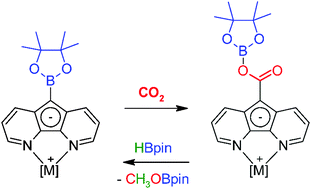Insertion of CO2 into the carbon–boron bond of a boronic ester ligand†
Abstract
New Ru and Zn diazafluorenyl complexes undergo C–H borylation of the diazafluorenyl ligand to form the corresponding diazafluorenylboronic ester complexes, which can insert CO2 into their C–B bonds to form boryl ester functionalities. The relevance of these new reactivities towards catalytic CO2 reduction has also been explored.


 Please wait while we load your content...
Please wait while we load your content...